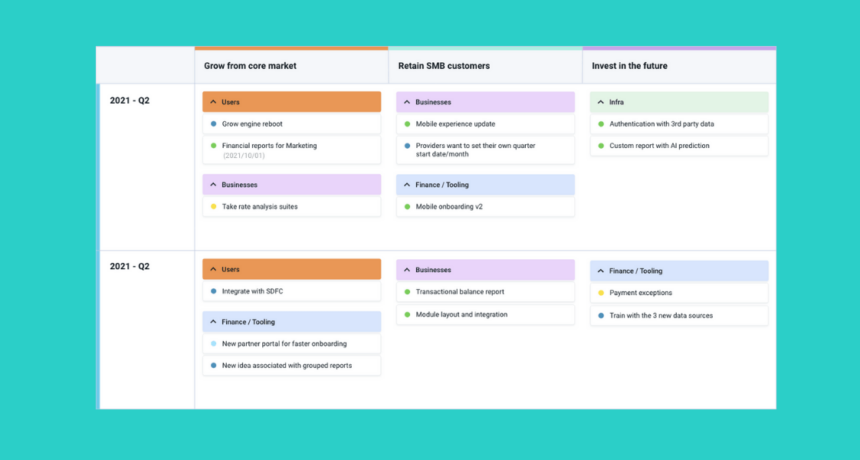One of the most important skills a great product manager should have is the ability to communicate the story behind their product roadmap. They should also know when and how to shift the story’s perspective depending on their audience. For example, customers typically want to see the progress of requested features. At the same time, C-suite execs need clarity about how the features you prioritized will help them achieve their business goals.
How can you choose a suitable format for your audience? By exploring some great product roadmap examples. Below, we share five product roadmaps you can create on-demand in Dragonboat. But don’t feel like you have to pick just one. You might like to work in one format and present the data in another. And that’s easy with the right product roadmap tool.
What is a Product Roadmap?
As a reminder, a product roadmap is a visual representation of your product strategy that shows what your product development teams plan to do, when they will do it, and why. It is invaluable for communicating with stakeholders inside and outside the organization.
Product teams have created roadmaps for many years and used to build them using basic office applications like spreadsheets or slide decks. However, given our increasingly dynamic business environment, most teams have switched to collaborative tools that empower them to keep up with rapidly changing conditions while staying focused on the product vision.
What is the Purpose of a Product Roadmap?
Product managers use roadmaps for many different purposes – from presenting high-level strategic plans to day-to-day project management. That is why you might have found yourself drawn to an article about product roadmap examples – because of their varied uses, picking the proper format can be challenging. Ultimately, it’s all about clear, concise, accurate, and timely communication.
For example, you might pull up your product roadmap on a mobile app during lunch with a salesperson to show them your short-term and long-term product release plans. Or, create a public product roadmap where you can share critical features and time frames to build trust and solicit customer feedback. So, let’s move on to the examples of roadmaps to give you more context.
5 Product Roadmap Examples and When to Use Them
1. Kanban Board Product Roadmap
We recommend creating a Kanban or Trello board-style roadmap for daily roadmapping activities. With Kanban boards, you use columns to visualize work in progress, with the simplest form being columns for “To Do,” “Doing,” and “Done.” But you can also use them to visualize tasks in other ways – by goal or product, for instance.
Ideal Audience
While this is an excellent format for sharing your roadmap, you may find it best for personal use because it allows you to spot issues and deal with them quickly.
Benefits
When you create this type of product roadmap format in Dragonboat, you can easily:
- Plan with drag-and-drop editing.
- Display data by various groupings (e.g., group by timeframe, quarter, or goal), then add, drag-and-drop, and prioritize ideas or initiatives within each column.
- Roll up efforts to see the estimated allocation for your selected grouping.
- Apply filters to show only relevant values.
How to Set It Up
You can create your Kanban board in Dragonboat in 3 simple steps:
- Define your portfolio dimensions – These are the product areas, goals, themes, timeframes, etc., you want in your roadmap. In Dragonboat, we call them “portfolio dimensions,” but you might also hear them referred to as “strategic pillars,” “strategic drivers,” or something else.
- Add epics and initiatives to plan for a longer horizon – While brainstorming, add your ideas, epics, and initiatives. Then, group or align each initiative to its related goals and other strategic drivers.
- Assess and prioritize at the idea or initiative level in various dimensions, such as by objective, category, theme, focus, etc.
Now, you have an excellent Kanban board roadmap that presents your plan:
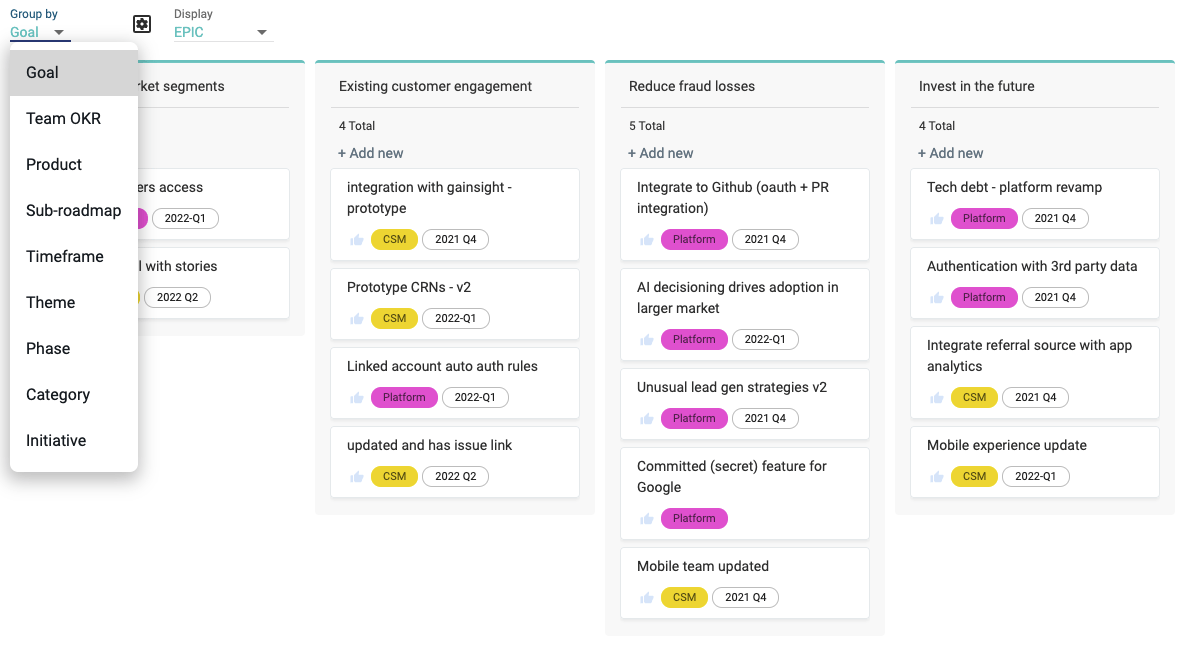
2. Slide Deck or Executive Summary Product Roadmap
Is 50 percent of your time devoted to building PowerPoint presentations? In Dragonboat, you can streamline this process by automatically visualizing your roadmap as a slide or executive summary.
Ideal Audience
A versatile format, you can use this product roadmap example in edit mode for planning purposes or to present evergreen slide decks to any stakeholder.
Benefits
- Choose any information you want to share; it’s 100% customizable.
- There is no need to build and update slide decks manually.
- Save views that tailor your roadmap story for your audience so you can quickly return to them later.
How to Set It Up
Choose the data you want in the columns and rows, select the portfolio level, and group within each cell to communicate information concisely – tweaking the information for stakeholders with different needs.
This format includes an edit mode for planning and a share mode for presenting to stakeholders. You can then share saved views via email, Slack, Confluence, or direct links to read-only users.
Editing is as easy as dragging and dropping between areas.
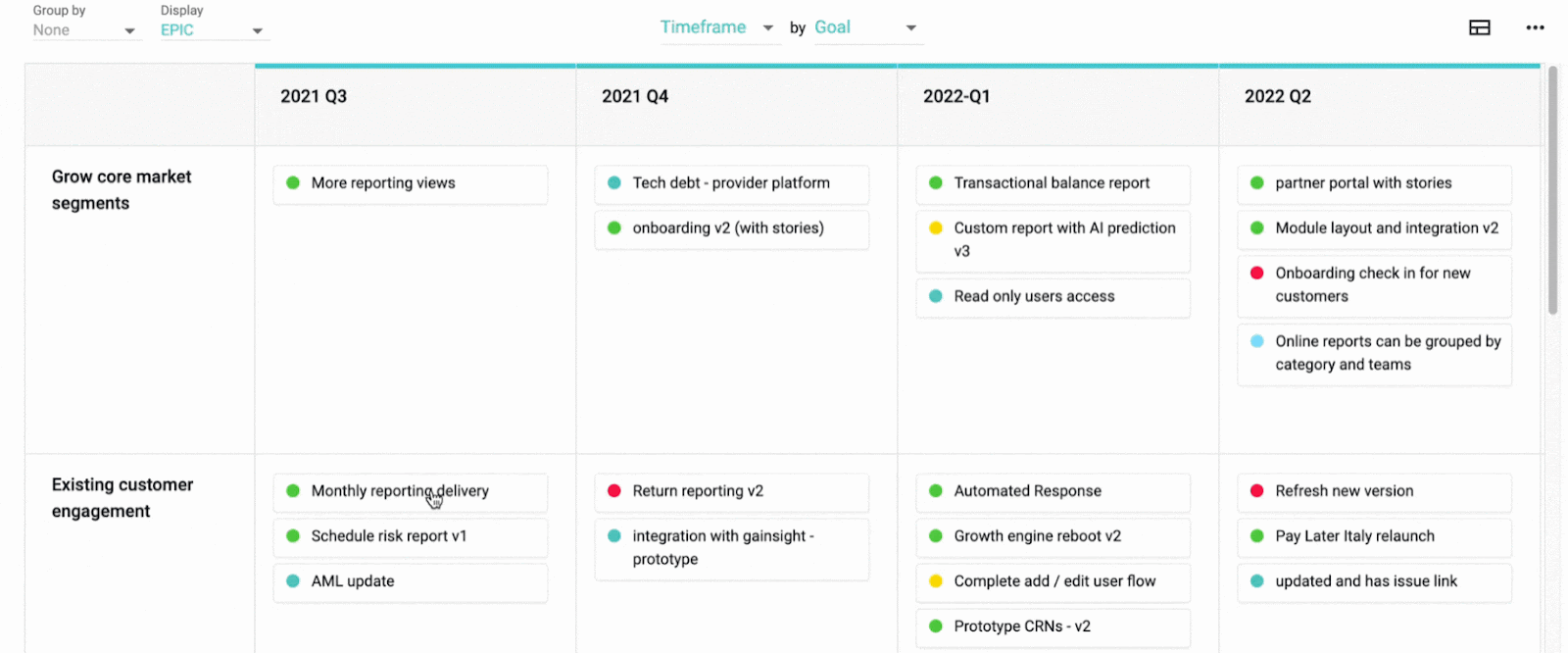
Let’s look at more examples of product roadmaps in the slide deck summary format:
Product Roadmap Slide for Customer-Facing Teams
Show customers in the rows and quarters in the columns to indicate when you plan to build features requested by various customers.
This product roadmap format is ideal for sharing with your sales and CSM team so they can update customers as needed.

Product Roadmap Slide for an All-Hands Meeting
Let’s say you are a Head of Product and want to show what your teams are doing to help the company reach its goals. Use the slide deck roadmap format to present teams (in the rows) by goal (in the columns) and display all corresponding items at the initiative level.
If you look at it with only the product team, you can display epics or features instead.
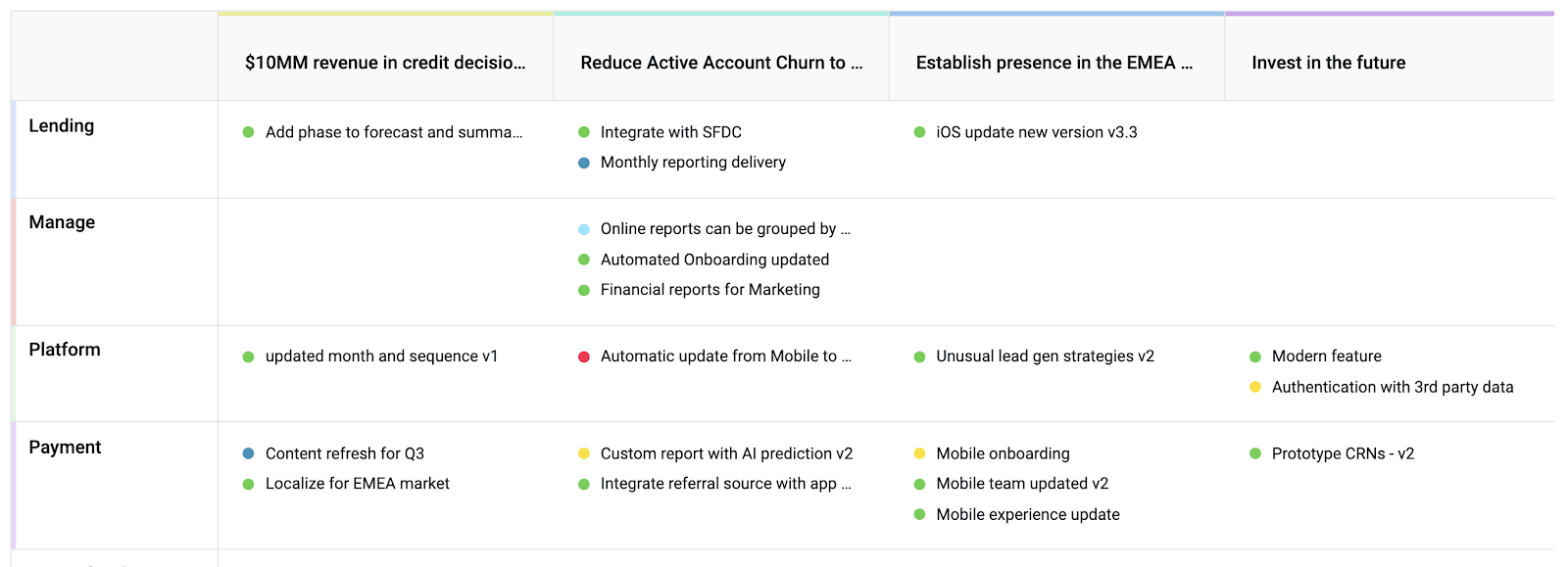
Product Roadmap Slide for Executive Updates
Use a Quarter by Teams summary, like the one below, to provide visibility and keep everyone aligned.
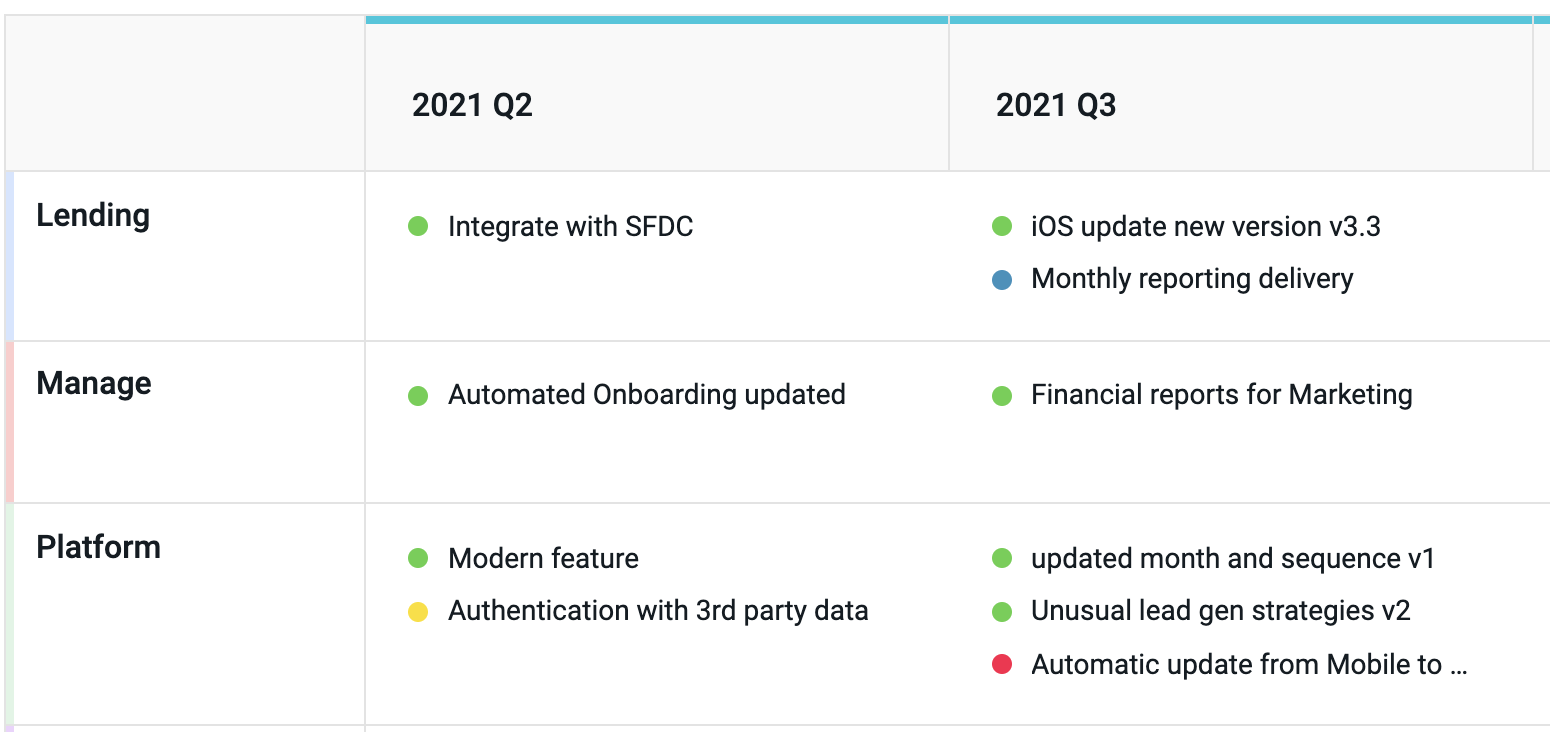
3. Swimlane Product Roadmap
A swimlane roadmap is your roadmap presented as a timeline. Similar to the rest of the formats in Dragonboat, you can group your roadmaps in any of the portfolio dimensions to tell the appropriate stories to each audience.
Ideal Audience
Executives will be pleased to see your roadmap in this compact timeline. You might also want to use it for planning purposes because it’s easy to move things around and see how different items line up without requiring the exact timeframes or release dates.
Benefits
- Visualize and manage dependencies.
- Easily plan things without needing to know the exact dates.
- Show a lot of detail in a compact timeline.
How to Set It Up
Group portfolio dimensions into lanes, customize colors to tell the right story, and drag and drop between lanes to adjust your timeline. To illustrate, let’s look at some swimlane roadmap views that product managers built in Dragonboat.
Initiatives Each Product Team is Working On To Achieve Goals

Initiatives and Epics an Individual Product Team Is Working On To Achieve Goals
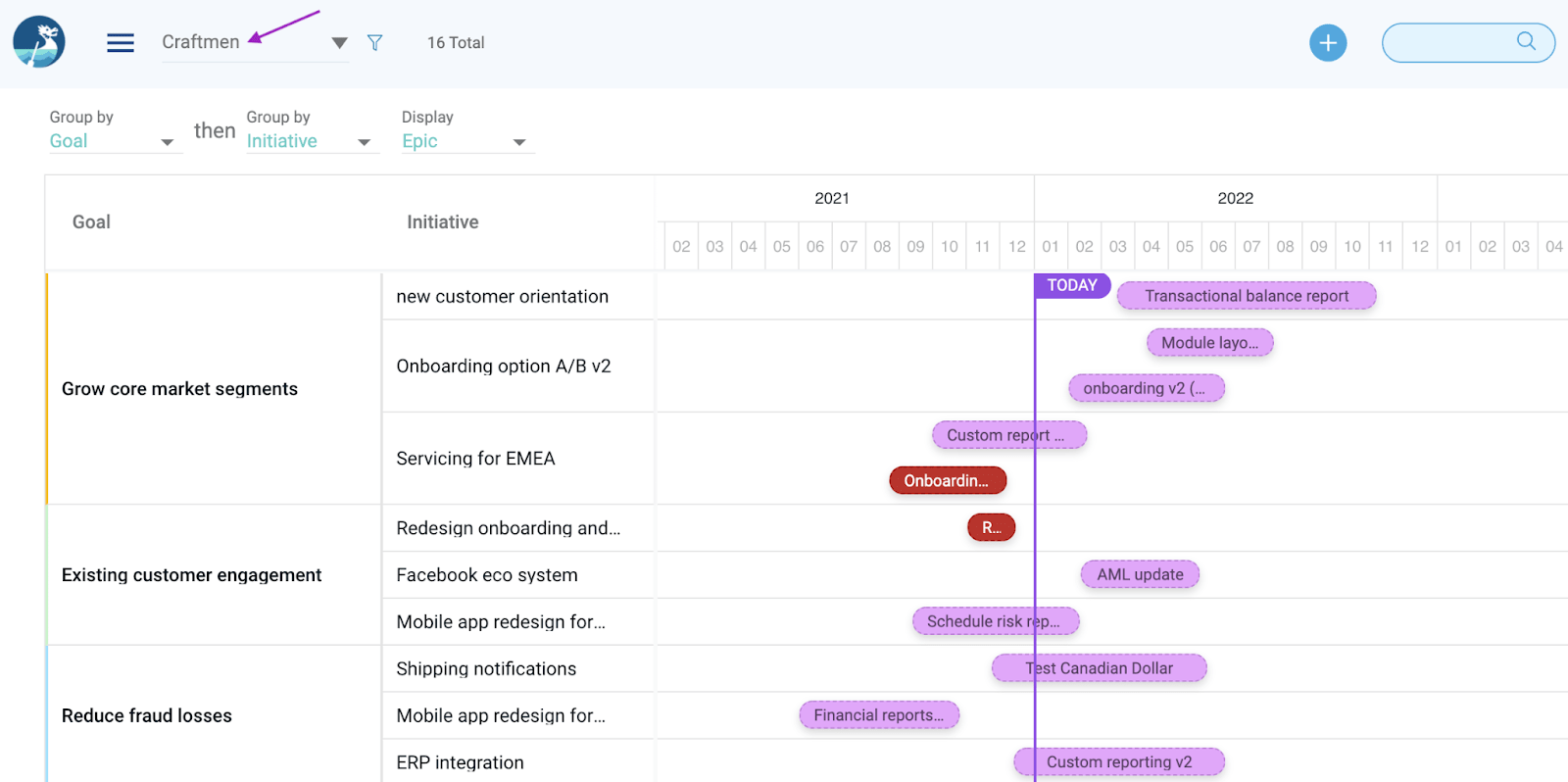
4. Gantt Chart Product Roadmap
Product managers often use Gantt charts to show activities displayed against time. This format in Dragonboat has a story mode that makes tracking progress and roll-up easier, along with real-time updates.
Ideal Audience
This product roadmap example is ideal for sharing with program managers (PMOs) who can help with planning, execution, and reporting. It also makes it a breeze to manage dependencies.
Benefits
- Display multiple levels and groupings.
- Edit in a cell just like you would in a spreadsheet.
- Enjoy real-time updates with other tools, like Jira, for the mapped fields.
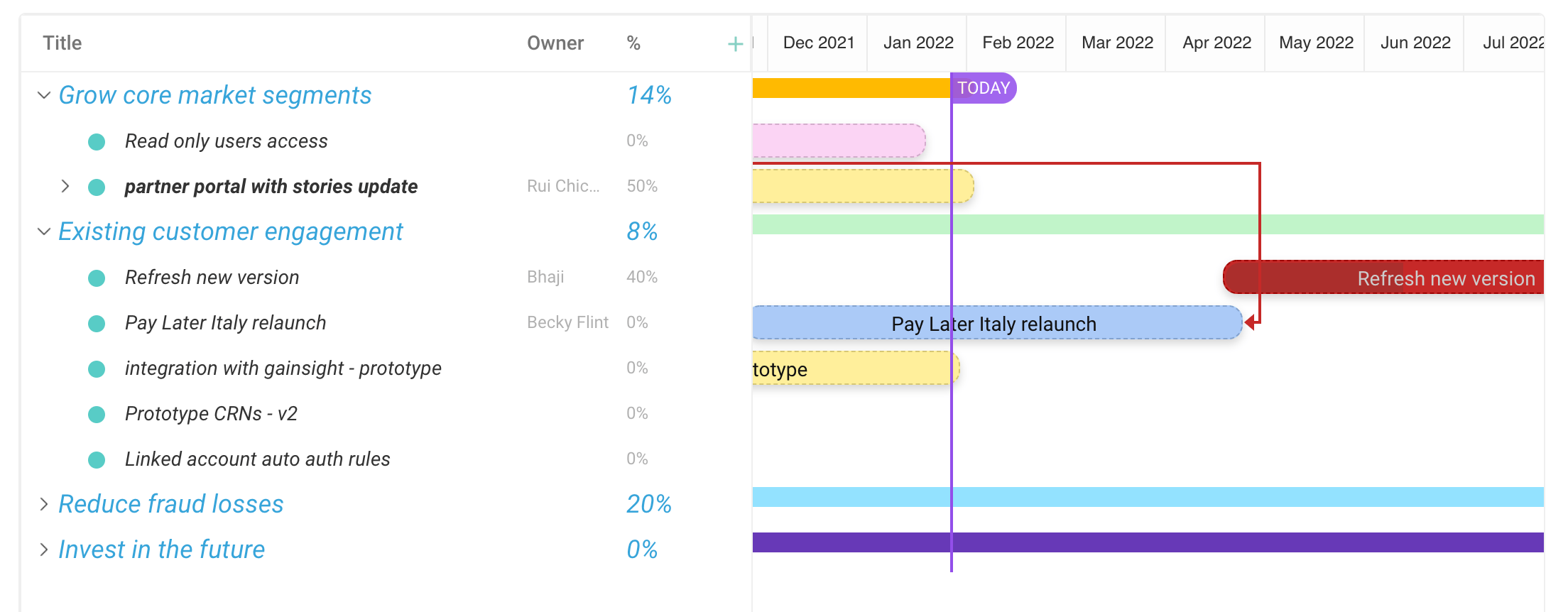
5. Spreadsheet List-Style Product Roadmap
Creating your product roadmap as a list is a highly flexible option. If you have used spreadsheets to manage your product roadmap, this is the new and improved version!
In Dragonboat, this is the ideal format for organizing your plans from multiple perspectives, such as:
- Scope (aka hierarchy): Epics may be part of an initiative (a bigger, multi-epic or team endeavor), which may be part of a bet (if your company has multi-year items).
- By dimensions (OKR, roadmap, timeframe, or quarter).
- By planning stage.
Ideal Audience
This product roadmap example is especially nice for sharing with product operations colleagues, as they will likely prefer to have a lot of data on one page. Since this format displays many fields, you could use it when going through your initiatives in a status meeting.
Benefits
- Flexible and customizable for your unique needs.
- Useful for both planning and sharing with various audiences.
- Back up your decisions in ‘score view’ and add comments to provide context.
Let’s look at examples of what you can make in list view:
Roadmap Status Report in List View

Prioritization View

Dragonboat also has multiple product prioritization frameworks baked in to suit your needs.
How to Build a Product Roadmap
Are you ready to build a roadmap using one of the product roadmap examples above? Here are the basic steps:
- Establish your overall company objectives and product goals.
- Determine which product initiatives to prioritize in pursuit of those goals.
- Break each initiative down into the actions you must take to deliver – features you will develop, the documentation you will create, and so on.
- Determine the timeline – what will happen and when given your priorities and available resources.
And, remember, a great product manager is a masterful storyteller. Use the roadmap examples above (and an excellent tool) to present your message clearly and compellingly to ease negotiations and get buy-in. Explore our solution today to learn more, schedule a demo, or try it for free.
